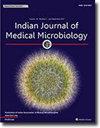急性脑炎综合征的诊断和监测算法:一种系统的病因鉴定方法
IF 1.4
4区 医学
Q4 IMMUNOLOGY
引用次数: 0
摘要
背景:急性脑炎综合征(AES)是一个主要的公共卫生问题,引起散发病例和高发病率和死亡率的暴发。其病因多样,包括许多人畜共患病原体,其诊断和管理在印度因地理、季节和文化多样性以及有限的诊断资源而变得复杂。作为ICMRs“同一个健康”倡议的一部分,本文阐述了对结构化诊断和监测算法的需求,以加强病因识别,改善AES管理和公共卫生应对。目的开发一种系统的AES诊断和监测算法,根据临床、流行病学和实验室结果对调查进行优先排序,以优化患者预后并加强公共卫生干预。结果提出的方法根据地理和季节病原体流行情况、与国家规划的一致性、治疗可及性、诊断可行性、临床和放射学怀疑以及公共卫生监测需求,优先考虑AES的病因诊断。AES病例应在二级或三级医疗机构进行管理,在那里可以根据资源可行性进行适当的检测。阳性和阴性样本的一个子集应该进行基因组鉴定,以确定新的病原体。结论该框架将加强病原体识别,改善患者管理,支持公共卫生工作,加强ICMR通过“同一个健康”方法打击AES的承诺。本文章由计算机程序翻译,如有差异,请以英文原文为准。
Diagnostic and surveillance algorithm for acute encephalitis syndrome: A systematic approach to etiological identification
Background
Acute Encephalitis Syndrome (AES) is a major public health concern, causing sporadic cases and outbreaks with high morbidity and mortality. Its diverse aetiology includes many zoonotic pathogens, and its diagnosis and management in India are complicated by geographical, seasonal, and cultural diversity, along with limited diagnostic resources. As part of the ICMRs “One Health" initiative, this paper addresses the need for a structured diagnostic and surveillance algorithm to enhance etiological identification and improve AES management and public health response.
Objective
To develop a systematic diagnostic and surveillance algorithm for AES diagnosis, prioritizing investigations based on clinical, epidemiological, and laboratory findings to optimize patient outcomes and strengthen public health interventions.
Result
The proposed approach prioritizes AES etiological diagnosis based on geographical and seasonal pathogen prevalence, alignment with national programs, treatment availability, diagnostic feasibility, clinical and radiological suspicion, and public health surveillance needs. AES cases should be managed at secondary or tertiary care facilities, where appropriate tests can be conducted based on resource feasibility. A subset of positive and negative samples should undergo genomic characterization to identify novel pathogens.
Conclusion
This framework will enhance pathogen identification, improve patient management, and support public health efforts, reinforcing ICMR's commitment to combating AES through the “One Health" approach.
求助全文
通过发布文献求助,成功后即可免费获取论文全文。
去求助
来源期刊

Indian Journal of Medical Microbiology
IMMUNOLOGY-
CiteScore
2.20
自引率
0.00%
发文量
154
审稿时长
73 days
期刊介绍:
Manuscripts of high standard in the form of original research, multicentric studies, meta analysis, are accepted. Current reports can be submitted as brief communications. Case reports must include review of current literature, clinical details, outcome and follow up. Letters to the editor must be a comment on or pertain to a manuscript already published in the IJMM or in relation to preliminary communication of a larger study.
Review articles, Special Articles or Guest Editorials are accepted on invitation.
 求助内容:
求助内容: 应助结果提醒方式:
应助结果提醒方式:


